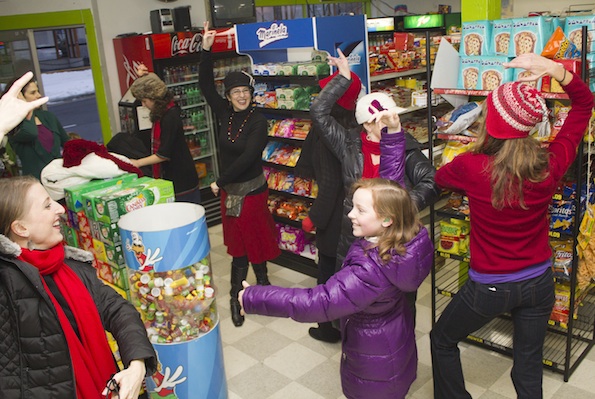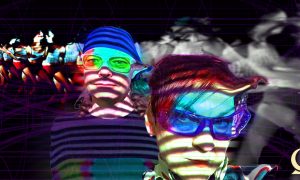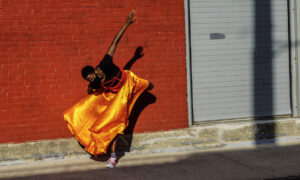By Stephanie Wolf of Dance Informa.
Creative Placemaking = “The act of people coming together to change overlooked and undervalued public and shared spaces into welcoming places where the community gathers, supports one another and thrives. Places can be animated and enhanced by elements that encourage human interaction—from temporary activities, such as performances and chalked poetry, to permanent installations, such as landscaping and unique art.”
When the construction for the Central Corridor light rail line in St. Paul began in 2011, Minnesota-based Springboard for the Arts recognized an opportunity to turn a three-year construction process into a mechanism for creating art and fostering community.
At the time, the organization was already investigating the relationships between artists and their corresponding communities, as well as examining how communities valued their artists. Ideas were set into motion to create a model for artist-led creative placemaking initiatives.
Exploring art as function
Springboard analyzed what Artist Community Organizer Jun-Li Wang calls the “vacuum and chaos created by construction.” The initial idea was to “survive the three years of construction,” said Wang. But it ultimately became about bridging the gap between the arts and its surrounding community.
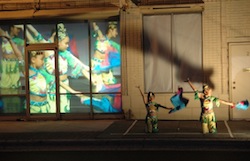
Irrigate event. Photo courtesy of Springboard for the Arts.
The timing was serendipitous, as the conception of the project Irrigate corresponded with the launch of ArtPlace, a Chicago-based organization that supports creative placemaking efforts through grants and loans. ArtPlace became the first financial backer for Irrigate, and continues to assist with funds and counsel.
The current Irrigate mission is two-pronged. According to Wang, the first strategy is to “train and support artists to be creative placemakers,” thus encouraging them to have a personal investment in their community. The second goal is to “create long-term, permanent infrastructures” and resources to keep artists in the community and attract new ones.
Be a part of Irrigate
There are six neighborhoods that share the six-mile stretch of the Central Corridor light rail line. Springboard invites all artists living in these areas to participate in the program. To be eligible as a contributor, Springboard asks artists to take a one-day workshop that covers creative placemaking, working cross-sector and utilizing collaborative tools. Once an artist has participated in the workshop, he or she can submit a proposal for a project, which must include a community collaborator. Each artist is eligible for $1,000 and can work in teams of up to three people, totaling in funds of $3,000 for a group project.
When artists register, Springboard doesn’t ask them what their artistic discipline is, nor does it require them to submit samples of their work. “Anyone who defines themselves as an artist is an artist,” says Wang. “We aren’t in the business of judging [art].”
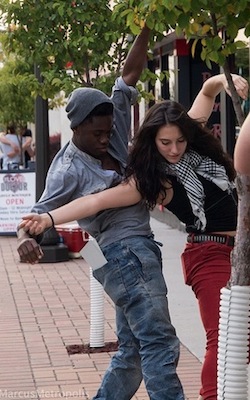
Dancers performing at an Irrigate event led by Samantha Johns. Photo by Marcus Metropolis, courtesy of Springboard for the Arts.
This open-armed approach results in a broad range of participating artistic genres: visual artists, dancers, musicians and even clowns. “We see art as a very large category,” she says. Down the road, Wang would love to see culinary artists get involved as well.
As of October 2013, Irrigate has trained 530 artists, 160 have accessed project support and about 100 projects have been installed or performed along the construction zone.
Dance as creative placemaking
Wang said many dancers have participated in Irrigate, “bringing life and interest” to various points along the Central Corridor light rail line. “There are lots of ways dancers can connect to community,” she said.
One dancer spent an afternoon at a highly trafficked intersection, dancing in the crosswalks and passing out flowers. Drivers and pedestrians lingered longer at the intersection to watch and, Wang hopes, they will think of that intersection differently now.
Around Christmas time, in the midst of a bone-chilling Minnesota winter, a flamenco dancer gathered a group of students to sing and dance in different businesses lining the light rail line. What Wang calls a “gesture for those businesses,” was a moment for artists and local establishments to create new connections—these are moments people will remember for a long time.
Reaping the benefits across the nation
More than beautifying local areas, Irrigate is ultimately about reshaping how artists value their communities and vice versa—this model can be adapted to suit communities across the country. Wang says one of its biggest advantages is its scalability, making Irrigate valuable for neighborhoods of varying sizes and with different needs.
While a similar program has launched in Cleveland, Irrigate appears to have been the first of its kind, according to Wang. “This seems to be fairly unique…from a field perspective,” says Wang in regards to the Irrigate element of community organizing.
Springboard is solidifying ways to help other places implement creative placemaking. Wang envisions this possibly following a similar format to the Community Supported Art (CSA) toolkit—offering a certain number of resources online for free and then, for a small fee, providing additional support and counsel. However, the process of sharing Irrigate is still in development.
“Our hope is really to support other places and help them support [creative placemaking in their communities],” says Wang. “The whole model is based on working with local assets.”
For more information about creative placemaking and the Irrigate program, visit www.SpringboardfortheArts.org/community-development/Irrigate.
Photo (top): Irrigate event. Photo courtesy of Springboard for the Arts.


